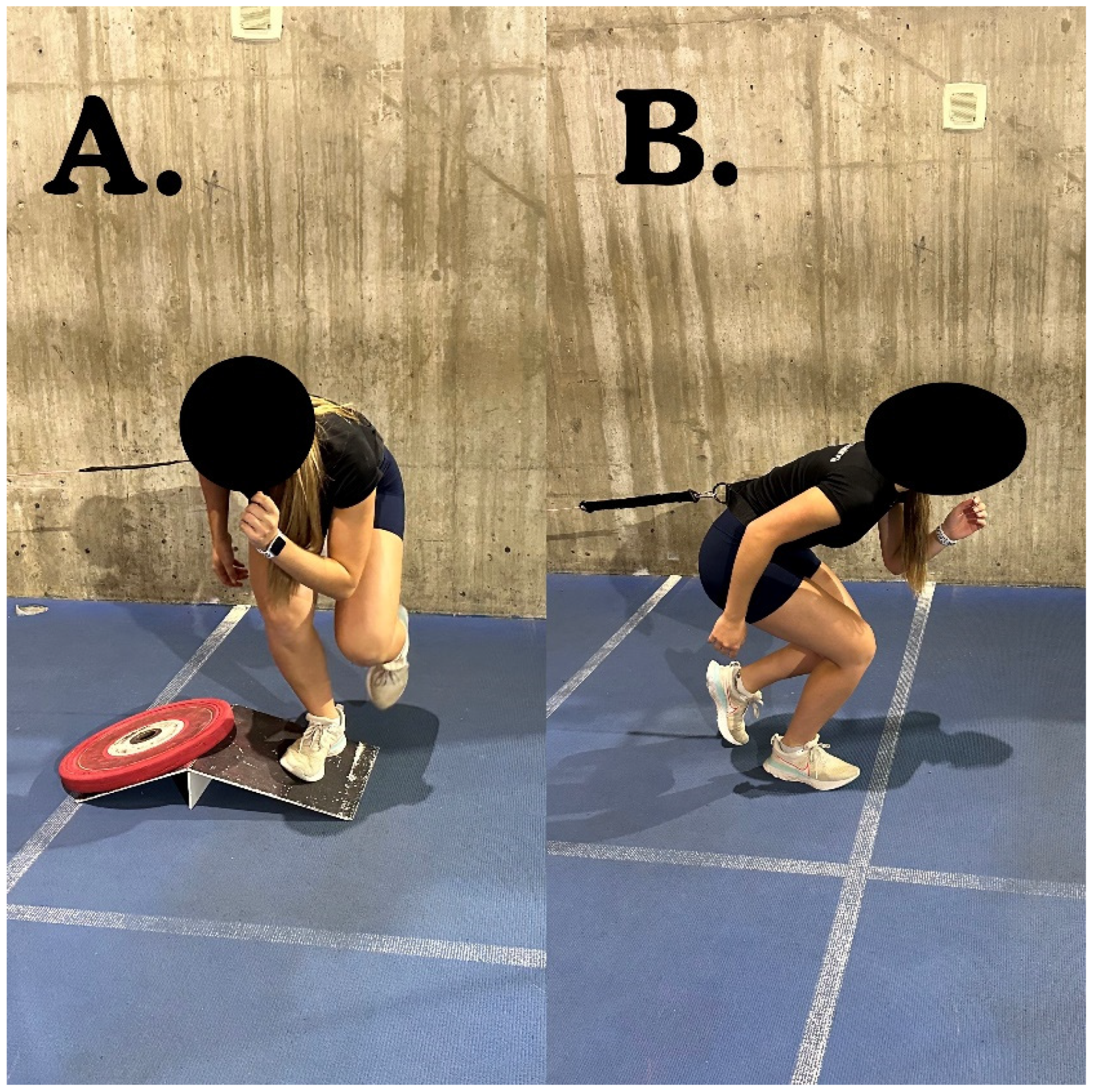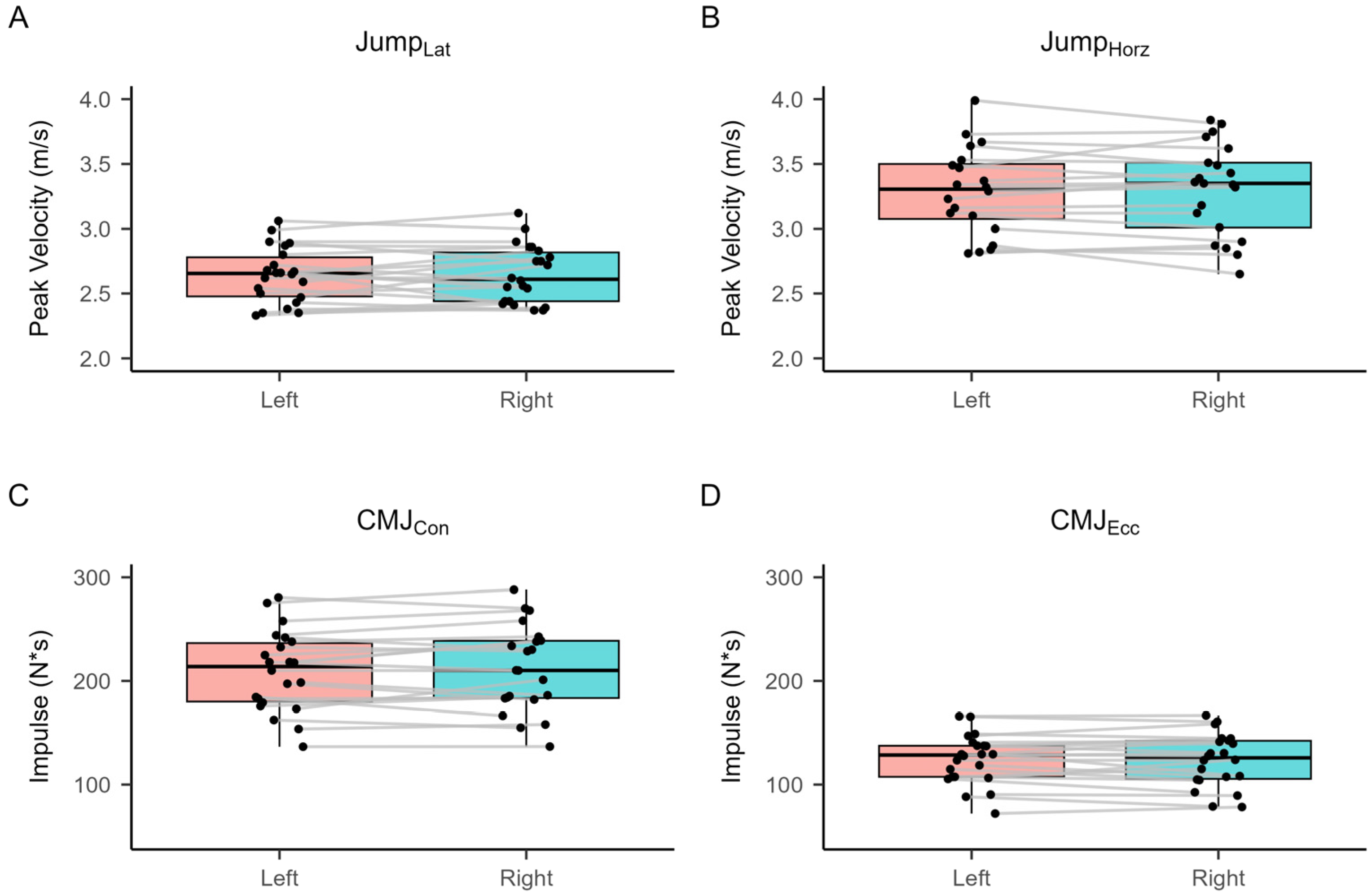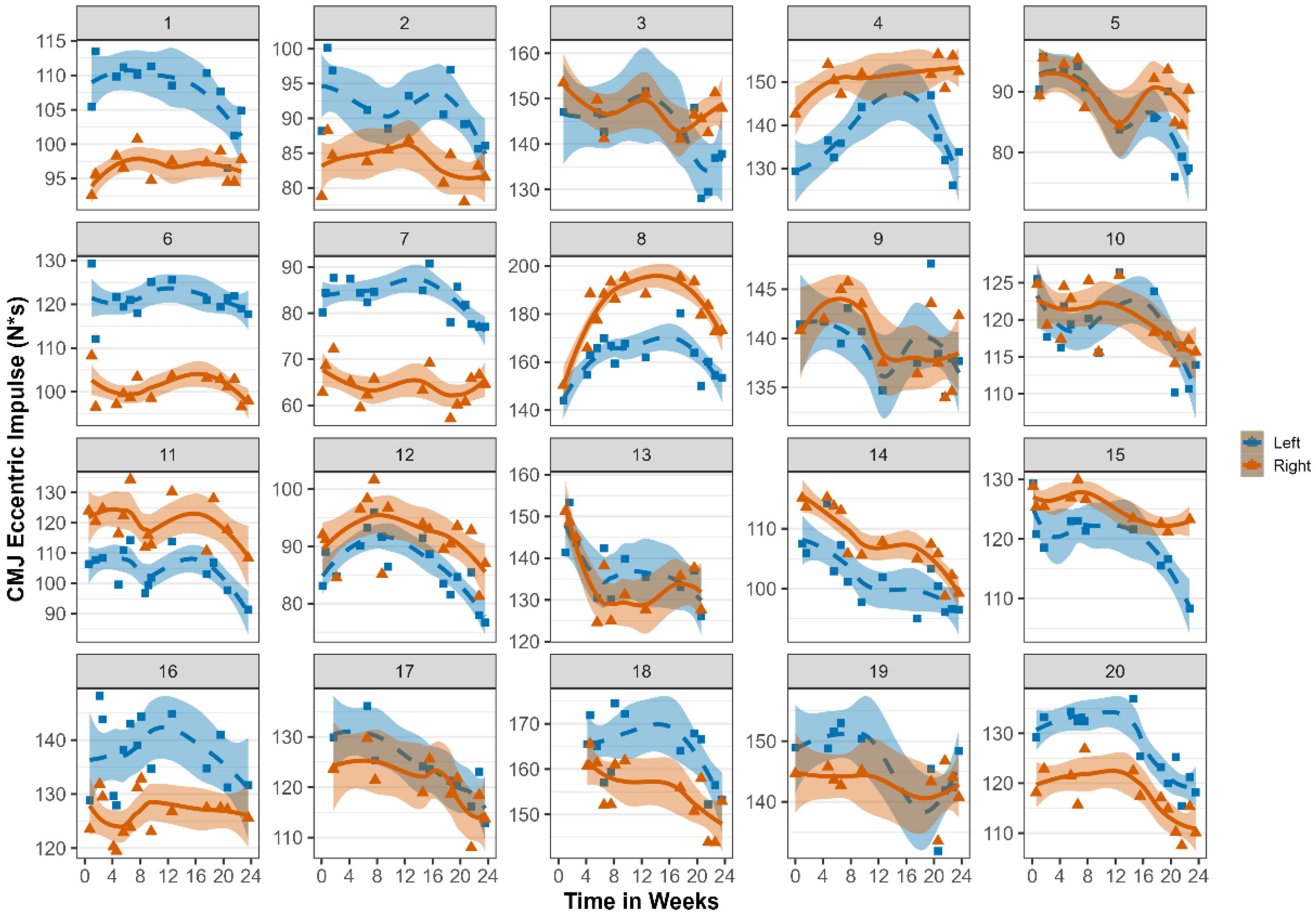Multi-Planar Jump Performance in Speed Skating Athletes: Investigating Interlimb Differences in an Asymmetrical Sport
Abstract
:1. Introduction
2. Materials and Methods
2.1. Subjects
2.2. Procedures
2.3. JumpLat and JumpHorz Protocols
2.4. Bilateral CMJ
2.5. Statistical Analysis
3. Results
3.1. Cross-Sectional Analysis
3.2. Longitudinal Analysis
4. Discussion
5. Conclusions
Author Contributions
Funding
Data Availability Statement
Acknowledgments
Conflicts of Interest
References
- Jordan, M.J.; Morris, N.; Barnert, J.; Lawson, D.; Witt, I.A.; Herzog, W. Forecasting neuromuscular recovery after anterior cruciate ligament injury: Athlete recovery profiles with generalized additive modeling. J. Orthop. Res. 2022, 40, 2803–2812. [Google Scholar] [CrossRef] [PubMed]
- Hart, L.M.; Cohen, D.D.; Patterson, S.D.; Springham, M.; Reynolds, J.; Read, P. Previous injury is associated with heightened countermovement jump force-time asymmetries in professional soccer players. Transl. Sports Med. 2019, 2, 256–262. [Google Scholar] [CrossRef]
- Jordan, M.J.; Aagaard, P.; Herzog, W. Lower limb asymmetry in mechanical muscle function: A comparison between ski racers with and without ACL reconstruction. Scand. J. Med. Sci. Sports 2015, 25, e301–e309. [Google Scholar] [CrossRef] [PubMed]
- O’Malley, E.; Richter, C.; King, E.; Strike, S.; Moran, K.; Franklyn-Miller, A.; Moran, R. Countermovement Jump and Isokinetic Dynamometry as Measures of Rehabilitation Status After Anterior Cruciate Ligament Reconstruction. J. Athl. Train. 2018, 53, 687–695. [Google Scholar] [CrossRef]
- Ebert, J.R.; Du Preez, L.; Furzer, B.; Edwards, P.; Joss, B. Which Hop Tests Can Best Identify Functional Limb Asymmetry in Patients 9-12 Months After Anterior Cruciate Ligament Reconstruction Employing a Hamstrings Tendon Autograft? Int. J. Sports Phys. Ther. 2021, 16, 393–403. [Google Scholar] [CrossRef]
- Maloney, S.J. The Relationship Between Asymmetry and Athletic Performance: A Critical Review. J. Strength Cond. Res. 2019, 33, 2579–2593. [Google Scholar] [CrossRef]
- Afonso, J.; Peña, J.; Sá, M.; Virgile, A.; García-De-Alcaraz, A.; Bishop, C. Why Sports Should Embrace Bilateral Asymmetry: A Narrative Review. Symmetry 2022, 14, 1993. [Google Scholar] [CrossRef]
- McMaster, D.T.; Gill, N.; Cronin, J.; McGuigan, M. A brief review of strength and ballistic assessment methodologies in sport. Sports Med. 2014, 44, 603–623. [Google Scholar] [CrossRef]
- Samozino, P.; Morin, J.-B.; Hintzy, F.; Belli, A. Jumping ability: A theoretical integrative approach. J. Theor. Biol. 2010, 264, 11–18. [Google Scholar] [CrossRef]
- O’Brien, T.D.; Reeves, N.; Baltzopoulos, V.; Jones, D.A.; Maganaris, C.N. Strong relationships exist between muscle volume, joint power and whole-body external mechanical power in adults and children. Exp. Physiol. 2009, 94, 731–738. [Google Scholar] [CrossRef]
- Murtagh, C.F.; Vanrenterghem, J.; O’boyle, A.; Morgans, R.; Drust, B.; Erskine, R.M. Unilateral jumps in different directions: A novel assessment of soccer-associated power? J. Sci. Med. Sport 2017, 20, 1018–1023. [Google Scholar] [CrossRef] [PubMed]
- Maulder, P.; Cronin, J. Horizontal and vertical jump assessment: Reliability, symmetry, discriminative and predictive ability. Phys. Ther. Sport 2005, 6, 74–82. [Google Scholar] [CrossRef]
- Bishop, C.; Read, P.; Chavda, S.; Jarvis, P.; Brazier, J.; Bromley, T.; Turner, A. Magnitude or Direction? Seasonal Variation of Interlimb Asymmetry in Elite Academy Soccer Players. J. Strength Cond. Res. 2022, 36, 1031–1037. [Google Scholar] [CrossRef] [PubMed]
- Bishop, C.; Abbott, W.; Brashill, C.; Loturco, I.; Beato, M.; Turner, A. Seasonal Variation of Physical Performance, Bilateral Deficit, and Interlimb Asymmetry in Elite Academy Soccer Players: Which Metrics Are Sensitive to Change? J. Strength Cond. Res. 2023, 37, 358–365. [Google Scholar] [CrossRef] [PubMed]
- Bishop, C.; Read, P.; Lake, J.; Chavda, S.; Turner, A. Interlimb Asymmetries: Understanding How to Calculate Differences from Bilateral and Unilateral Tests. Strength Cond. J. 2018, 40, 1–6. [Google Scholar] [CrossRef]
- Bishop, C.; Shrier, I.; Jordan, M. Ratio Data: Understanding Pitfalls and Knowing When to Standardise. Symmetry 2023, 15, 318. [Google Scholar] [CrossRef]
- De Koning, J.J.; De Groot, G.; Schenau, G.J.V.I. Speed Skating the Curves: A Study of Muscle Coordination and Power Production. Int. J. Sport Biomech. 1991, 7, 344–358. [Google Scholar] [CrossRef]
- Born, D.-P.; Zinner, C.; Herlitz, B.; Richter, K.; Holmberg, H.-C.; Sperlich, B. Muscle Oxygenation Asymmetry in Ice Speed Skaters: Not Compensated by Compression. Int. J. Sports Physiol. Perform. 2014, 9, 58–67. [Google Scholar] [CrossRef]
- Hettinga, F.J.; Konings, M.J.; Cooper, C.E. Differences in Muscle Oxygenation, Perceived Fatigue and Recovery between Long-Track and Short-Track Speed Skating. Front. Physiol. 2016, 7, 619. [Google Scholar] [CrossRef]
- van Hilst, J.; Hilgersom, N.F.; Kuilman, M.C.; Kuijer, P.P.F.; Frings-Dresen, M.H. Low back pain in young elite field hockey players, football players and speed skaters: Prevalence and risk factors. J. Back Musculoskelet. Rehabil. 2015, 28, 67–73. [Google Scholar] [CrossRef]
- Varley, I.; Greeves, J.P.; Sale, C. Seasonal Difference in Bone Characteristics and Body Composition of Elite Speed Skaters. Int. J. Sports Med. 2019, 40, 9–15. [Google Scholar] [CrossRef] [PubMed]
- Akahane, K.; Kimura, T.; Cheng, G.A.; Fujiwara, T.; Yamamoto, I.; Hachimori, A. Relationship between Balance Performance and Leg Muscle Strength in Elite and Non-Elite Junior Speed Skaters. J. Phys. Ther. Sci. 2006, 18, 149–154. [Google Scholar] [CrossRef]
- Xia, J.Y. The Comparative Analysis on Muscles of Short and Long Track Speed Skating Athletes. Appl. Mech. Mater. 2011, 117–119, 737–740. [Google Scholar] [CrossRef]
- Bussey, M.D. Does the demand for asymmetric functional lower body postures in lateral sports relate to structural asymmetry of the pelvis? J. Sci. Med. Sport 2010, 13, 360–364. [Google Scholar] [CrossRef] [PubMed]
- Cohen, D.; Burton, A.; Wells, C.; Taberner, M.; Díaz, M.; Graham-Smith, P. Single vs Double Leg Countermovement Jump Tests: Not half an Apple! Aspetar Sport Med. 2020, 9, 34–41. [Google Scholar]
- Bishop, C.; Turner, A.; Jarvis, P.; Chavda, S.; Read, P. Considerations for Selecting Field-Based Strength and Power Fitness Tests to Measure Asymmetries. J. Strength Cond. Res. 2017, 31, 2635–2644. [Google Scholar] [CrossRef]
- Zukowski, M.; Jordan, M.; Herzog, W. Single Leg Lateral and Horizontal Loaded Jump Testing: Reliability and Correlation with Long Track Sprint Speed Skating Performance. J. Strength Cond. Res. 2023. In Press. [Google Scholar]
- Bergkvist, C.; Svensson, M.; Eriksrud, O. Accuracy and repeatability of force, position and speed measurement of 1080 Quantum and 1080 Sprint. Stockholm 2015. [Google Scholar]
- Cohen, J. A Coefficient of agreement for nominal scales. Educ. Psychol. Meas. 1960, 20, 37–46. [Google Scholar] [CrossRef]
- Viera, A.J.; Garrett, J.M. Understanding Interobserver Agreement: The Kappa Statistic. Fam. Med. 2005, 37, 360–363. [Google Scholar]
- Bishop, C.; Abbott, W.; Brashill, C.; Turner, A.; Lake, J.; Read, P. Bilateral vs. Unilateral Countermovement Jumps: Comparing the Magnitude and Direction of Asymmetry in Elite Academy Soccer Players. J. Strength Cond. Res. 2020, 36, 1660–1666. [Google Scholar] [CrossRef] [PubMed]
- Bishop, C.; Pereira, L.A.; Reis, V.P.; Read, P.; Turner, A.N.; Loturco, I. Comparing the magnitude and direction of asymmetry during the squat, countermovement and drop jump tests in elite youth female soccer players. J. Sports Sci. 2019, 38, 1296–1303. [Google Scholar] [CrossRef] [PubMed]
- Pérez-Castilla, A.; García-Ramos, A.; Janicijevic, D.; Delgado-García, G.; De la Cruz, J.C.; Rojas, F.J.; Cepero, M. Between-session reliability of performance and asymmetry variables obtained during unilateral and bilateral countermovement jumps in basketball players. PLoS ONE 2021, 16, e0255458. [Google Scholar] [CrossRef] [PubMed]
- Hewit, J.K.; Cronin, J.B.; Hume, P.A. Asymmetry in multi-directional jumping tasks. Phys. Ther. Sport 2012, 13, 238–242. [Google Scholar] [CrossRef] [PubMed]
- Bishop, C.; Lake, J.; Loturco, I.; Papadopoulos, K.; Turner, A.; Read, P. Interlimb Asymmetries: The Need for an Individual Approach to Data Analysis. J. Strength Cond. Res. 2021, 35, 695–701. [Google Scholar] [CrossRef] [PubMed]
- Sovak, D.; Hawes, M.R. Anthropological status of international calibre speed skaters. J. Sports Sci. 1987, 5, 287–304. [Google Scholar] [CrossRef]
- Menegaldo, L.L.; Aragão, L.; Matta, T.; de Oliveira, L.F. Hip Adduction and Abduction Torque-angle Curve Characterization of Speed Skating Athletes. Int. J. Sports Med. 2020, 41, 248–254. [Google Scholar] [CrossRef] [PubMed]
- Benjanuvatra, N.; Lay, B.; Alderson, J.; Blanksby, B.A. Comparison of ground reaction force asymmetry in one- and two-legged countermovement jumps. J. Strength Cond. Res. 2013, 27, 2700–2707. [Google Scholar] [CrossRef]
- Mitchell, A.; Holding, C.; Greig, M. The Influence of Injury History on Countermovement Jump Performance and Movement Strategy in Professional Soccer Players: Implications for Profiling and Rehabilitation Foci. J. Sport Rehabil. 2021, 30, 768–773. [Google Scholar] [CrossRef]
- Alba-Jiménez, C.; Moreno-Doutres, D.; Peña, J. Trends Assessing Neuromuscular Fatigue in Team Sports: A Narrative Review. Sports 2022, 10, 33. [Google Scholar] [CrossRef]
- Silvis, M.L.; Mosher, T.; Smetana, B.S.; Chinchilli, V.M.; Flemming, D.J.; Walker, E.; Black, K.P. High prevalence of pelvic and hip magnetic resonance imaging findings in asymptomatic collegiate and professional hockey players. Am. J. Sports Med. 2011, 39, 715–721. [Google Scholar] [CrossRef] [PubMed]




| Male | Female | |
|---|---|---|
| Cross-sectional Analysis | ||
| n | 12 | 10 |
| Age (yrs.) | 21.8 ± 1.4 | 22.8 ± 2.3 |
| Body Mass (kg) | 82.4 ± 6.3 | 64.6 ± 3.4 |
| Longitudinal Analysis | ||
| n | 20 | 12 |
| Age (yrs.) | 22.0 ± 1.4 | 22.3 ± 2.5 |
| Body Mass (kg) | 81.1 ± 2.2 | 63.9 ± 2.5 |
| Right | Left | Mean Difference (95% CI) | p | |
|---|---|---|---|---|
| Peak Velocity (m/s) | ||||
| JumpLat | 2.65 ± 0.22 | 2.64 ± 0.21 | 0.01 (−0.06 to 0.05) | 0.77 |
| JumpHorz | 3.34 ± 0.38 | 3.36 ± 0.38 | −0.02 (−0.03 to 0.07) | 0.33 |
| Impulse (N*s) | ||||
| CMJCon | 209 ± 46 | 209 ± 39 | 0 (−26 to 25) | 0.98 |
| CMJEcc | 127 ± 30 | 124 ± 24 | 3 (−20 to 13) | 0.65 |
| Comparison | Kappa Coefficient | Agreement |
|---|---|---|
| JumpLat-JumpHorz | −0.17 | Poor |
| JumpLat-CMJCon | 0.03 | Poor |
| JumpHorz-CMJCon | 0.21 | Slight |
| CMJCon-CMJEcc | 0.33 | Slight |
| CMJEcc-JumpLat | −0.01 | Poor |
Disclaimer/Publisher’s Note: The statements, opinions and data contained in all publications are solely those of the individual author(s) and contributor(s) and not of MDPI and/or the editor(s). MDPI and/or the editor(s) disclaim responsibility for any injury to people or property resulting from any ideas, methods, instructions or products referred to in the content. |
© 2023 by the authors. Licensee MDPI, Basel, Switzerland. This article is an open access article distributed under the terms and conditions of the Creative Commons Attribution (CC BY) license (https://creativecommons.org/licenses/by/4.0/).
Share and Cite
Zukowski, M.; Herzog, W.; Jordan, M.J. Multi-Planar Jump Performance in Speed Skating Athletes: Investigating Interlimb Differences in an Asymmetrical Sport. Symmetry 2023, 15, 1007. https://doi.org/10.3390/sym15051007
Zukowski M, Herzog W, Jordan MJ. Multi-Planar Jump Performance in Speed Skating Athletes: Investigating Interlimb Differences in an Asymmetrical Sport. Symmetry. 2023; 15(5):1007. https://doi.org/10.3390/sym15051007
Chicago/Turabian StyleZukowski, Matthew, Walter Herzog, and Matthew J. Jordan. 2023. "Multi-Planar Jump Performance in Speed Skating Athletes: Investigating Interlimb Differences in an Asymmetrical Sport" Symmetry 15, no. 5: 1007. https://doi.org/10.3390/sym15051007
APA StyleZukowski, M., Herzog, W., & Jordan, M. J. (2023). Multi-Planar Jump Performance in Speed Skating Athletes: Investigating Interlimb Differences in an Asymmetrical Sport. Symmetry, 15(5), 1007. https://doi.org/10.3390/sym15051007








